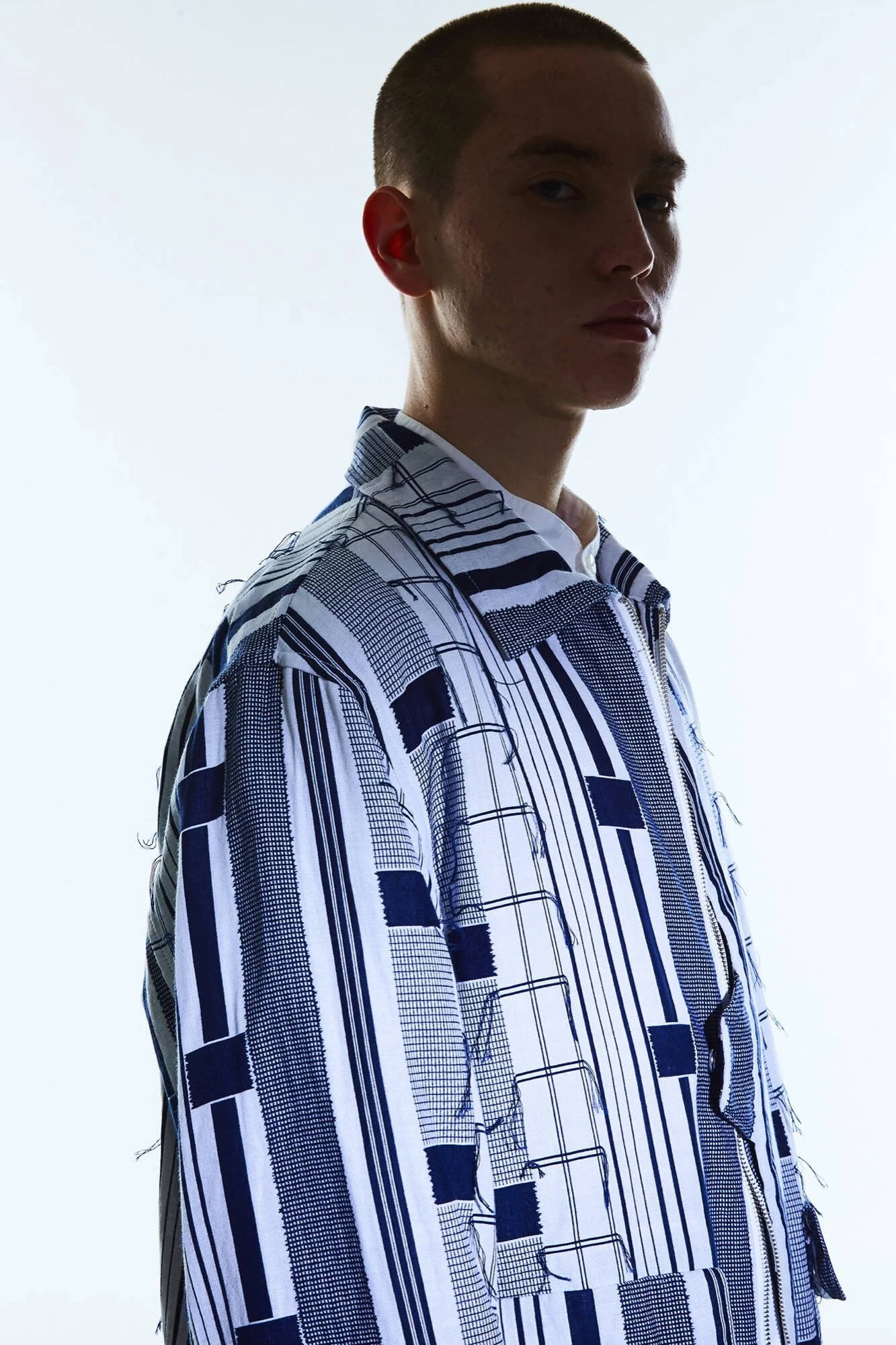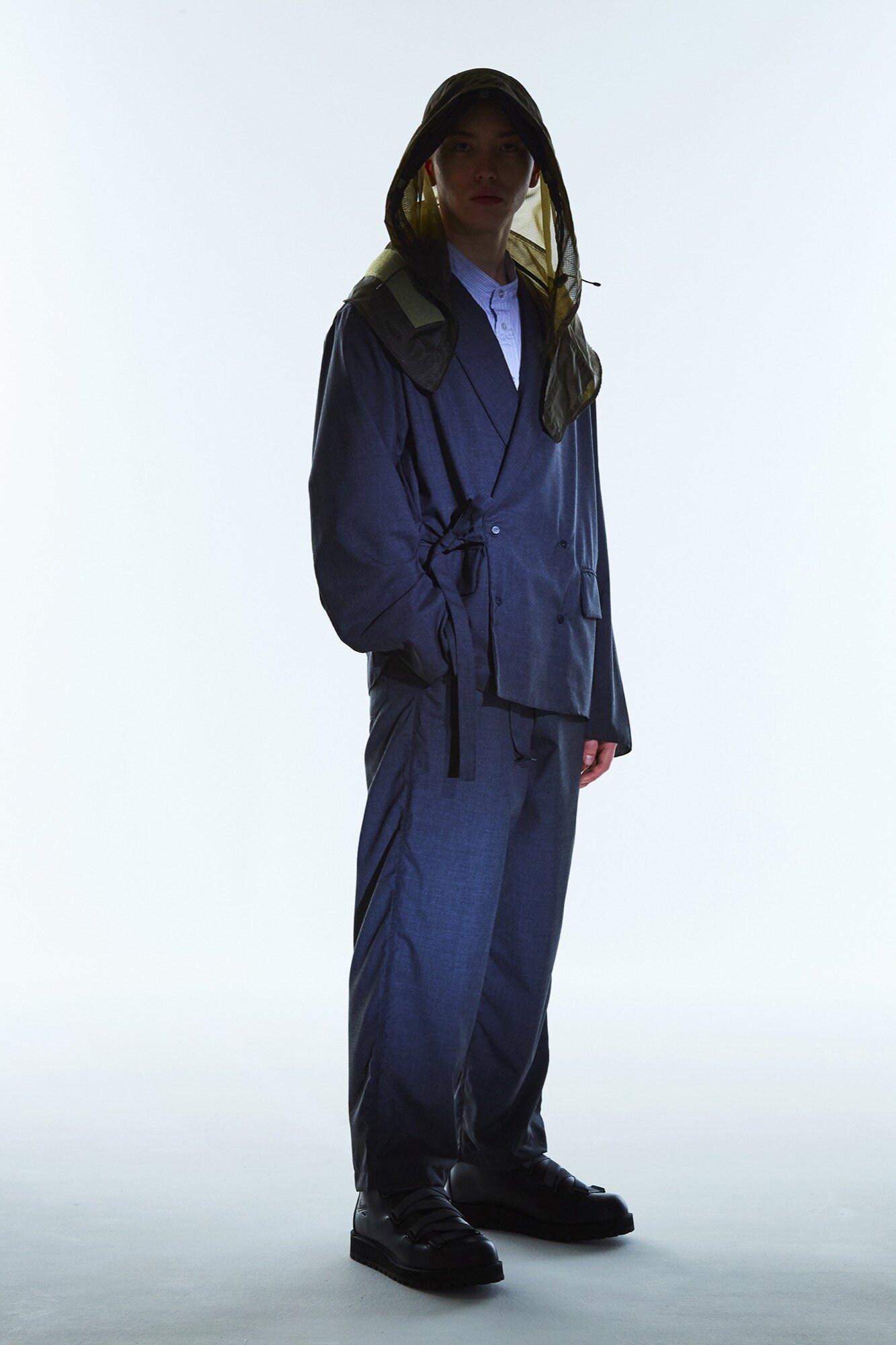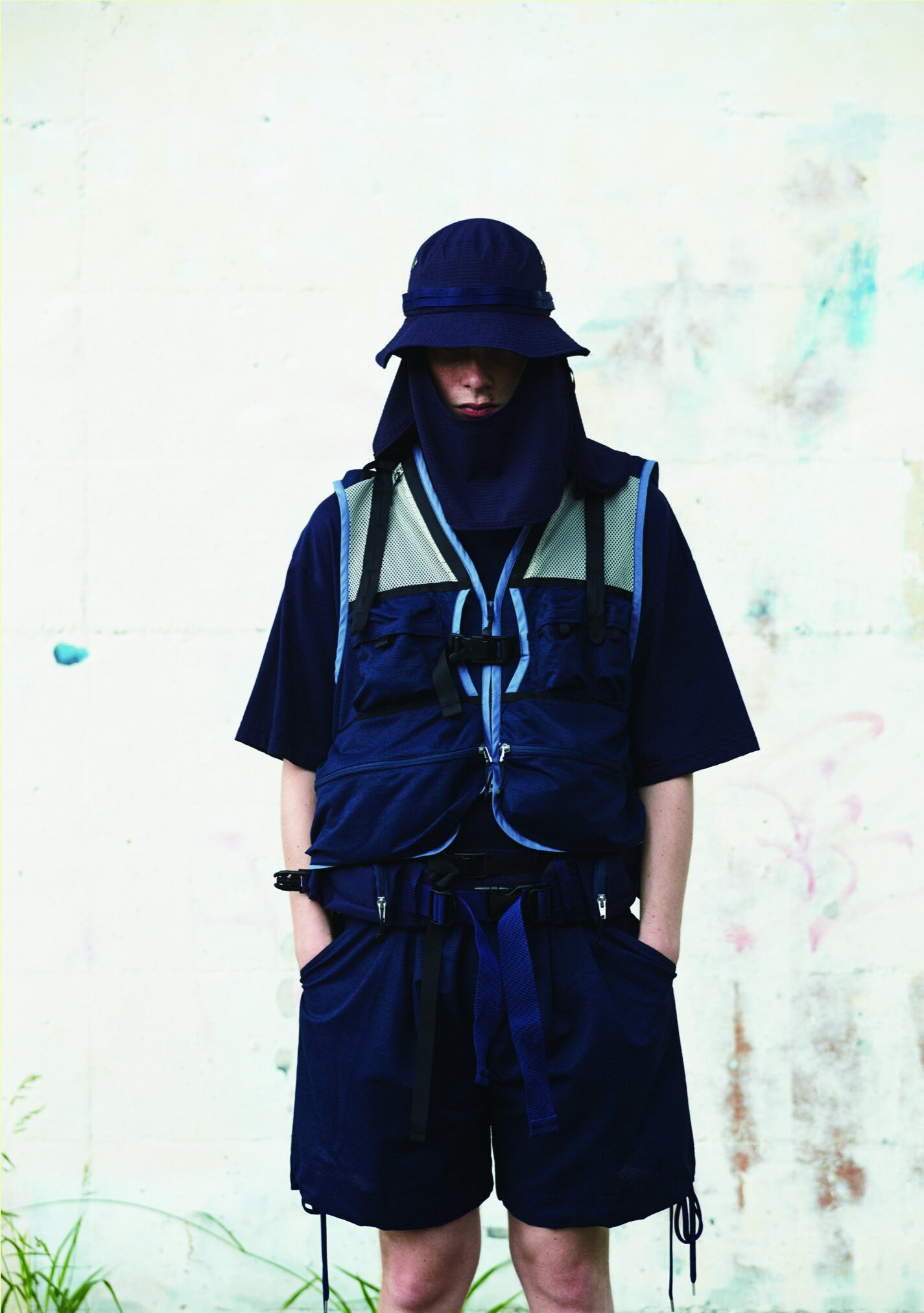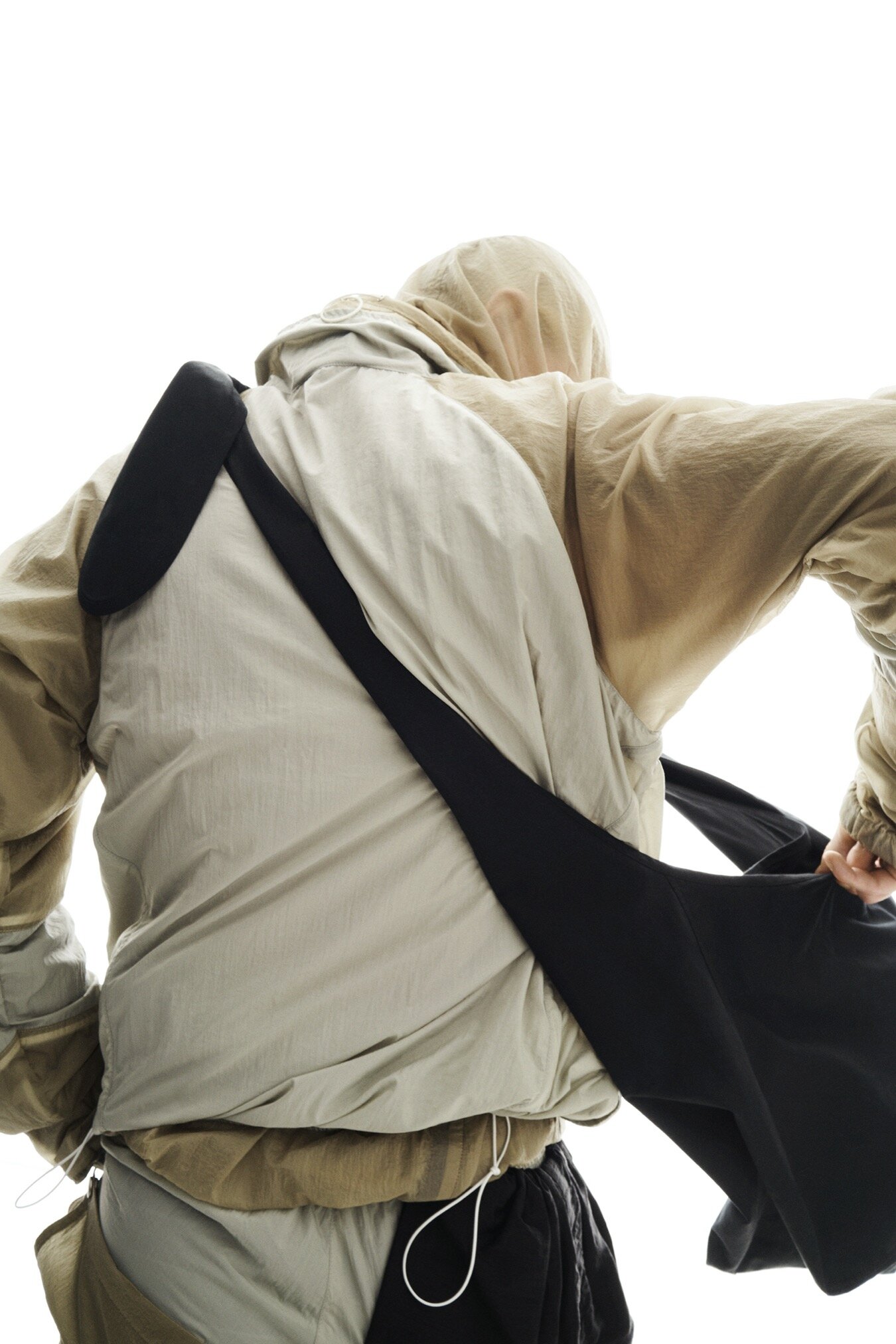Form and Function: meanswhile and Clothing as a Tool

This introduction into meanswhile is part of a continuing series that examines functional wear by focusing on the designers and brands that are making an impression on a segment of the fashion industry which prioritizes progressive fabrics and specialized features.
Functional wear is defined by garments that are meant to make everyday life easier. Whether it is through insulation for a cold winter night, breathability on a hot summer day, or water resistance for those times you get caught in the rain on your way to work - no matter the situation, functional wear prioritizes garments that are capable of dealing with the unexpected scenarios that life can throw at us.
For functional wear, the value of a design is not found in an idea that merely sounds good on paper, or in a trend that garners more likes on your latest social media post. Instead, functional wear establishes the value of a design based on its integrity, that is, its ability to effectively respond to its intended use. As such, when it comes to functional wear, both the layperson and seasoned enthusiast are guided by the following question: what are the real-world scenarios that this particular garment is meant to serve? In other words, is the garment practical?
If there is a brand that best demonstrates a mastery in functional wear and design, it is meanswhile. Founded by Naohiro Fujisaki, meanswhile was created in 2014 and has since developed a reputation for utility-heavy garments that balance a forward-looking vision that is both wearable and experimental in its execution.
Acclaimed for their technologically driven use of materials, meanswhile blends highly functional outdoor clothing with a Japanese styling that encompasses a range of modern and traditional silhouettes. Naohiro Fujisaki’s approach to design also boldly examines the boundaries of wearability by offering an array of items that integrate progressive qualities such as convertible detailing and maximalist proportions. And when it comes to seasonal roll outs, their unique twist on traditional silhouettes and modern utility comes packed with a variety of colourful textiles and fabric treatments that are venerated by both outdoor enthusiasts and urban commuters alike.
What gives Naohiro Fujisaki a unique position within the industry is that meanswhile is an explicitly concept-driven brand. When exploring meanswhile’s web store or social media accounts, you will come across two concepts that articulate their design philosophy: “clothing as a tool” and “design as a means to an end, not the end itself.” As a series on functional wear, these two mottos caught our attention right away because they not only provide insight into Naohiro Fujisaki’s unique perspective on design, but because they explain why practicality is a sought-after value that defines the spirit of the functional wear community.
The way that the meanswhile concepts demonstrate the functional wear ethos is that “the clothing as a tool” idea indicates that garments should exist in the same way a tool does. Similar to a carpenter’s saw, clothing is meant to improve our interactions with the world by helping us achieve our day-to-day goals, not hinder them. Wherein the idea that “design is a means to an end, not the end itself” suggests that design should not be valued simply for the sake of its aesthetics, but for the function that the design is intended to serve.
Like the design of a tool (which is designed to help accomplish a specific task), the design of garments should be enhanced by the particular demands that we expect to undertake throughout our day.
Together, the two meanswhile concepts help illustrate the functional wear movement in an unambiguous manner: the design of garments should be guided by its intended, real-world, practical use.
With all these thoughts in place, let us take a closer look at some of the meanswhile pieces to see how the principles of functional design manifest in the production of garments.
When it comes to the use of technical and progressive materials, the meanswhile autumn and winter 2018 collection has countless examples. For this collection, Naohiro Fujisaki made use of modern utilitarian fabrics such as Ventile cotton and X-PAC canvas. The X-PAC canvas is a lightweight, high tear strength resistance cotton that minimizes the overall weight of the textile, whereas the Ventile cotton is a waterproof fabric that provides high breathability. An item that best demonstrates the use of these textiles is the X-PAC luggage vest.
By using these materials, the vest comes equipped to take on various scenarios like heavy rain or unexpected impact from scraping against external surfaces. Additionally, the vest has large-capacity pockets that were designed in a way to function like a bag that can be accessed from the front. These progressive materials were showcased in a range of offerings that included trousers, jackets, button-downs, and back packs.
Functional wear is not something that is solely defined by the materials a garment is made from but is also a feature that is implemented at the level of design. A standout example of this is the Solotex reversible 4-way jacket from the spring and summer 2018 collection. In terms of the materials, the 4-way jacket makes use of Solotex and MVS yarn. Solotex is a soft, stretchy texture with gentle cushioning that has a spring-like structure to make textile products more comfortable to wear, whereas the MVS yarn is specially designed to absorb water quickly, suppress pilling, and resist wrinkles. Additionally, unlike a typical 2-way reversible jacket, the 4-way jacket is akin to origami because it can be worn in four different styles by turning it over from the hem in specific ways. This design feature is not only remarkable from a design perspective, but it is also extremely practical because there are four different styles that are packed into one jacket. This level of versatility is unfounded in a single garment and is definitely something that will come in handy for travel situations that require as little luggage as possible.
Following a tour of the meanswhile headquarters in Tokyo, we were given the opportunity to ask Naohiro Fujisaki a few questions. Our interview covers everything from his humble beginnings as a student, the creative process, and his take on the future of the fashion industry. Read the full interview below to learn more about meanswhile and Naohiro Fujisaki’s rise to the top.
Dear Naohiro Fujisaki, can you please tell us about your beginnings? What drew you to design and fashion?
In high school I used to remake clothes I found at vintage shops, as well as my parents’ clothing. That was probably the start, but I didn’t seriously consider design until I entered fashion college.
What were you doing before you founded the brand, what is your story leading up to the creation of your brand?
After graduating from college, I found work at a collection brand where I got my start in various assistant positions such as production and pattern making. I then moved on to street brands, and experienced working in smaller start-ups as well. During this period, I began working on a backpack design in my spare time and it was when I completed it that I decided to start my own brand. This entire process took three years and countless revisions until I arrived at a product that I was satisfied with.
What were your inspirations to become a designer? And where does the name meanswhile come from?
Honestly, I never had aspirations to become a designer. I just always enjoyed making things and thought it would be great if I could turn that interest into a career. My father was a visual artist so seeing him, I thought that I would naturally do something similar.
As for the brand name, “mean” equals “意味” in Japanese, a concept I want all the products I create to have. “Means” comes from the word “手段,” a method or way of doing something where design is not an end goal, but a process. These two notions are not something that is often considered of value in the fashion industry where many just aim to become “mainstream.” When I entered this industry, I wanted my merits to be based on my own philosophy and that’s how “meanswhile” came about.
Did you study design? If so, were utilitarian themes common when you became interested in pursuing a career in the fashion industry?
I studied clothing design in college. As I was entering, my father told me one thing which was “to observe the natural world.” In nature, all forms are the result of a purpose and exist as they are for a specific reason. Thanks to these words, I began to approach design from various aspects of our daily routines and lives.
During this time, utilitarian brands already existed. I was a fan of many and upon further research, I discovered that there were quite a few. I can’t say if this was the result of it being trendy to do so, but the prevalence of this theme would not continue to exist if it was just another fashion trend.
Can you talk about your emphasis on practical, functional, and utilitarian clothing? What do these words mean to you and our design-work?
Functionality is 100% the essence of design. For a person in any design field, this is the most basic foundation. However, in regard to fashion, this is not always the case. I find that if I stick to the meaning of what true design is, the functional/practical aspects of what I am creating naturally presents itself. With meanswhile, I like to not only emphasize this point, but find balance in presenting it in ways that may not be obvious to the eye.
Your designs are nothing short of attention-grabbing. What are some of the design inspirations for your work?
Thank you! I often find inspiration from daily life. This answer ties back to my point a few questions earlier, but I also often look to nature. For example, take a plant with differently growing leaves. While I know this is because of its sun intake, thoughts such as “why?” and “how?” allow me to probe into why things exist the way they do - which is an important part of the creative process for me. Of course, I do also take inspiration from architecture and product design, and other man-made objects.
Upon doing research, we found the concepts “clothing as a tool” and “design as a means to an end, not the end itself” really thought-provoking. As a designer, what led to this unique take on clothing?
I see clothing being divided into two categories, daily wear and costume. As a college student, I designed wedding dresses and even placed number 1 in Japan at a design competition. For females, wedding dresses are something worn on a very special day and what I consider costume. For a long time, I only thought about clothing worn on these occasions and as a result, I began to think about daily wear, and how it should be utilized as a tool. This is how the brand concept came about. Having experienced designing from two different spectrums, I find I can approach the idea of “clothing as a tool” from a unique perspective.
Many of the design choices and silhouettes released from meanswhile present themselves as a perfect example of the way in which you can balance the traditional with the contemporary. What is it about meanswhile that is able to achieve this harmony?
This harmony is very important. For example, when it comes to design details, there are many designers who take inspiration from second hand and vintage clothing. I am guilty of this as well. However, to simply reproduce the details from clothing for modern day from say, 100 years ago, is the equivalent of cosplay. There are details found in clothing from 100 years ago that were designed to accommodate how people lived back then. What we carry now and how we travel has completely changed in the present day and to design for that will result in a different look. In my work, I try to infuse new functionalities and purpose into traditional details in order to make it relevant to the present.
The brands you collaborate with such as master-piece, KIDS LOVE GAITE, Danner, and Less Taiwan all seem to share a vision that aligns with yours. Is there anything specific you look for when it comes to deciding on collaborations?
When deciding on collaborations, I do not necessarily look for brands who share the same vision. Instead, I consider what new (different) values they hold. We’ve been able to create many interesting things by applying the meanswhile design philosophy to our collaborations without obscuring their identity, and this is something I would like to continue doing in the future.
meanswhile is a brand that seems to resonate with outdoor enthusiasts and urban commuters alike. What is it about your designs that is able to bring together these disparate groups of people that lead lives that are contrary in certain ways?
Our concept of “tools” was initially quick to catch on with those who liked the outdoors, while the popularity of outdoor functionality had already found its place in city life. From this, outdoor clothing evolved to cater to a more style-conscious crowd, blurring the line between “outdoor” and “urban.” I think our success can be largely attributed to a market that was ready to accept these new boundaries.
Is bringing people together through a common interest intentional for your brand, or would you say it is an unintended by-product of design done right?
It is not intentional, but I am happy that is the case. Regardless of genre or category, I believe clothing should be something that imbues new values onto its wearer, and design with this goal in mind. As it is not rare for those in the city to have outdoor hobbies as well, the act of selecting clothes to accommodate a variety of lifestyles is something I hope becomes more commonplace.
Is there a specific season or article of clothing that you would say highlights your work, or something you love to look back at?
There is quite a bit I am proud of, such as winning the “Tokyo New Designer Fashion Grand Prix” and “Tokyo Fashion Award.” My promotional collaboration with Nike also comes to mind.
What are your highlights from the current SS20 collection and what can we expect from the upcoming season?
There are many pieces, but I would say our Danner collaboration boots, as well as the anorak. With every season, we do make small updates to it and it has become a standard item in our collection.
Most of the stores you’re stocked in is within Asia, can the western world expect to experience your world anytime soon?
I’m not sure if it is due to geography, but Asian shops were quick to show interest in us. As early as our second season, I received inquiries from stores in places such Taiwan, Hong Kong and Korea - many of whom are still carrying us to this date. There have been bumps in the road, but I believe these long standing relationships have had great positive effects on our growth. Although we do have some dealers in Europe, we do not have a presence in North America yet. I see this as our next challenge.
You recently worked with Nike and Hypebeast, what was this project about, and will we ever see a release?
When I was first approached with this project by Hypebeast’s director, I couldn’t believe it. It was a great experience to work with a brand that had such global reach. I was given full agency to create what I wanted and decided on producing something that could be looked at more like a work of art instead of merchandise. As a result, the cost to produce the entire outfit was 10 times that of what it would have been in our normal collection.
The purpose of the project was to create something based on the Air Max shoe in order to commemorate Nike Air Max Day. As we all know, what makes the shoe special is not that there is air inside, but the idea to reveal its inner technology by making it visible to the wearer. I applied this concept to aspects that make meanswhile’s pieces functional - such as cords, tapes, reflectors, etc. While these parts make up the framework of our clothing, they usually remain hidden. By adding clear watch windows to the jacket, I was able to showcase their importance. I have considered releasing it; however, the price would be astounding…
In a recent interview, you were asked about how meanswhile was affected by the Coronavirus crisis. In it, you stated that “Even before this all occurred, the fashion industry had already reached a point in which change was needed…” What change do you think was needed in the fashion industry?
The current industry has been built on applying “best by” dates on clothing in terms of trends, with brands being forced to push out new collections every 6 months. There is nothing wrong in creating new things, however, there is nothing good about unnecessary mass-produced items that end up being thrown out in mass as well. As a consumer, we should not feel forced to purchase because of trends, but because the lifestyle we lead calls for it. I believe it is these lifestyle choices that shape our style and make it unique. While I do create, that doesn’t necessarily mean my aim is to make as many sales as possible. I hope to spread my ideas and philosophy, and through that, spark conversation about how this industry operates.
Can you tell us anything specific about how it is the fashion industry reached a point where changes needed to be made?
This overlaps with my previous answer but I believe change has to start from those already in the industry. In Japan, the word “sustainable” has taken root but it is not something that is seriously considered. Utilizing sustainable fabrics, starting an eco-friendly brand etc., this is all just done to ultimately sell more. I don’t see the value in producing just to sell. It is funny that the notion of “humans as a race have to continue to live on this earth” has been utilized as a trend to push consumption. While sustainability wasn’t widespread when I started my brand, I do hope that my ideology of “clothing as a tool” can spread and help to alleviate some of the issues in the world.
What does the future of fashion look like to you? Where are we heading and how do you plan to position meanswhile in the next few years?
I have no idea what the future holds. Whether fashion goes the way of traditional art, becomes a past-time for a just a small group of people, or takes on a completely different form, I can’t say. As in the past, I do believe that fashion is a product of the times and the people who were there. meanswhile is a brand based on this concept as well. The starting point of many brands has been a reaction to the present situation, and as the times change, I think we will find that our roles and function will also change. It is my hope that meanswhile can adapt to whatever is to come. As a designer, I do want to continue for the rest of my life, even if I am working in a different capacity,
If there are any students of design who are reading this article, is there any advice you would like to share with them?
This is a difficult question, but I would say first you should decide whether you want to be an artist or a designer. You should embrace the doubt and discomfort you feel around you and decide whether you want to somehow express that or try to solve it. The world is evolving at a fast pace and young people are great at handling these changes. When I think about what great creations are to come in the future, I can’t help but be excited.
Thank you a lot for your time
The forward thinking nature of meanswhile’s implementation of functionality brings us back to the basics in an enlightening, yet simplistic manner: clothes have a purpose. This is important to think about in two ways. First, Naohiro Fujisaki's take on design is an asset to the industry because it outlines the way in which clothing can make life easier. Instead of working against the elements, meanswhile’s designs allow us to work alongside the environment in an effective and reliable manner - that is, by enabling us to overcome the various predicaments that life will throw at us. Secondly, if we take a step back and think about the reason for clothing, that is, the purpose of a particular garment that we are interested in, then we might be able to make consumer decisions that are consciously informed. And in a world that is rife with ceaseless mass-market demands, fostering ways to develop more careful choices may be an effective ground-up solution to the fashion industry’s lethargic development of greener practices and infrastructure. This, in turn, shows us how Naohiro Fujisaki and meanswhile epitomizes the significance and necessity of functional wear: clothing, through the lens of function, can play an important role in our own lives and for the movement towards progress.
ABOUT THE AUTHOR
Raffi Aintablian is based in Toronto and received his master’s degree in philosophy. He is in the midst of applying to a postgraduate degree in clinical psychology, but whenever his head isn’t buried in books on the philosophy of mind, psychiatry, and the nature of consciousness, he’s always following up on various happenings in design, politics, and film.



































































